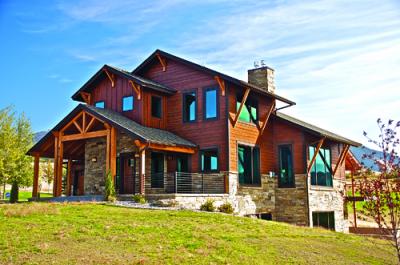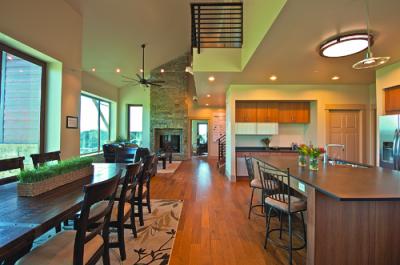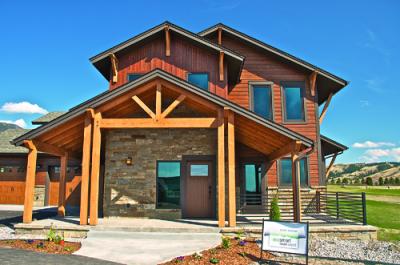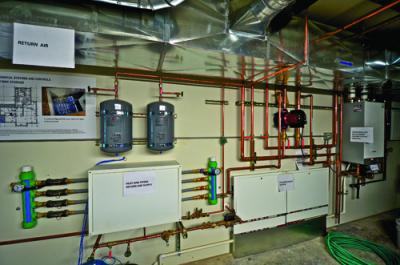Building Sustainably
The Rehau Montana Model

The noted geographer D. W. Meinig describes the West as a “process” in which the historical myth of the frontier and the majesty of the landscape creates an experience unique to the region. As more people seeking lifestyle amenities settle the West, challenges arise to address the landscape with a sensitivity that allows for growth and preservation. When Montana State University alumnus, Bill Hoy, decided to build his house in Bozeman, he saw a two-fold challenge. As an architect, he knew the significance of environmental sustainability. He also felt a responsibility toward what he calls “human sustainability.” The construction project became a commitment to energy efficiency, while the design concept sought “universal” accessibility for his parents’ retirement and his daughter’s wheelchair.
Hoy, senior vice-president with Wyndham Worldwide, bought a lot on the Bridger Creek golf course in 2006, planning to return with his wife and daughter to Bozeman where he had lived as a graduate of the MSU School of Architecture. The real bonus to the golf course location is not in the game but, as Hoy smilingly notes, “No one can build in front of me.” Describing his views of the southwest expanse of the valley as “sweeping” is an understatement.

Human sustainability and collaboration were themes repeated by those involved in the construction project. As an experiment in environmentally sensitive design, the design focuses on the coordination of “systems” or packaged elements, which comprise a construction project. These include heating and cooling equipment and the “envelope,” which encloses the house. (Think of an envelope as the wall or layer separating the outdoors from the temperature-controlled indoors.) Modular insulated concrete forms (ICFs) provide the structure for the first floor walls and floor while reducing energy consumption and harmful emissions associated with traditional building products. Structurally insulated panels (SIPs), manufactured in Belgrade by Big Sky Insulations, in the second floor walls and roof add to the energy and construction efficiencies.
As former president of the School of Architecture’s Advisory Council, Hoy helped establish the Creative Research Lab, with Terry Beaubois as director, to study multidisciplinary projects through the College of Art and Architecture. The Lab continues to coordinate the research phase of the house with the AAON Lab at MSU’s Department of Mechanical Engineering. Numerous engineering students spent hours on site during construction installing sensors that test the efficiency of the 12” exterior wall system. Additional sensors provide data comparing two different geothermal systems to forced air and solar panel arrangements. Considered an alternative to fossil fuels, renewable geothermal power works with the earth’s temperature to maintain comfortable levels of warmth. Hoy expects the redundancy of the systems will reveal an alternative for retrofitting houses throughout Montana.

Kathleen “Kitty” Saylor, former CEO with REHAU North America, met Hoy through a serendipitous business lunch in Virginia. When he showed her site pictures, the Choteau native recognized Bozeman. An impressive web of sponsors and players with MSU connections began with this lunch. Saylor notes enthusiastically that not only were so many alumni introduced and involved, but also these connections mirrored contributions from the College of Art and Architecture, the School of Film and Photography, the School of Business, and the Mechanical and Industrial Engineering Department. Furnishings are provided by MSU alumnus, Jake Jabs, president and CEO of American Furniture Warehouse. For Saylor, the notion of human sustainability takes on a broader interpretation as the project brought her from retirement back to Montana where she is Chief Executive in Residence with the MSU Foundation.
REHAU, an international manufacturer of polymer-based products, contributed extensively from tambour panels at kitchen cabinets to radiant floor elements, two types of geothermal heating units and fire suppression sprinklers. The windows combine REHAU European vinyl framing with a system of layered glass and film developed by another MSU alumnus, Harlan Byker, through his company, Pleotint. The “tilt-down” window-operating hardware not only locks out weather but allows the windows to be opened from the top or side depending on seasonal breezes. The film reacts to sunlight by creating an automatic shading system similar to the non-reflective qualities of a car’s rear-view mirror, a technology, Hoy notes, developed by Byker.
Anders Lewendal, chairman of SWMBIA’s Green Building Committee, agrees that research from the House contributes to the discussion of scalable investments in sustainability. At his suggestion, different types of insulation are being tested at different parts of the house.

REHAU house is open for research and meetings until the Hoys occupy it in 2014. Hoy hopes the research and experience gained will ultimately inform “how we should build in Montana and the Northern Rockies.” At over 4,000 square feet with three bedrooms, the house provides a large lab to challenge the innovative systems. For him, the average 1,200 square-foot house should be sustainable and affordable. Substantial investments of time and money in this prototype are directed toward that goal. More information is available at http://www.montanaecosmart.com
The kitchen focuses on accessibility. Topped with a recycled material available at Bozeman’s Refuge Building Center, the island opens to a double-height living area overlooking the Gallatin and Spanish Peak ranges. A wraparound open rail balcony connects the living area and views to a wing with private entry for Hoy’s parents and daughter. Wood and stone floors reflect the regional materials also detailing the exterior walls. A conference area opens to the great outdoors. Future plans include using on-site video technology for telemedicine conferences with institutions across the country. Arrangements can be made for meetings through Intermountain Property Management in Bozeman.

The biggest challenge for Saylor and contractor Jerry Tollefson involved the number of parties engaged in the project. Saylor readily acknowledges that working with so many interested groups across the country to solve so many unexpected problems was also the greatest reward. Students and professors from the Colleges of Business, Art and Architecture, and Engineering joined the mix that Tollefson describes as a challenge of “trying to keep 50 different cooks out of the kitchen”.
Jerry Tollefson has been in residential construction since 1977. Hoy and Saylor enthusiastically complement Tollefson and his subcontractors for their patience and willingness to work with the new systems. For future projects, Tollefson notes that the experience “proved the efficacy of a very efficient envelope.” Tollefson supports the use of geothermal systems from his experience in up-scale communities such as Big Sky where the higher front-end costs are more often manageable. His son, Travis, an MSU graduate in Construction Engineering Technology, worked daily on the job site, echoing the theme of multigenerational sustainability with the family construction business.
The collaboration necessary to complete a project such as the REHAU Montana Ecosmart House represents several important aspects of living in the West. The work between academic departments and the professional world reflects the highest ideals of Montana State. The respect and success achieved by the construction trades, manufacturers and researchers demonstrate the possibilities to expand environmentally responsible design. But finally, the result of all these efforts leads to a place where human sustainability — that process of living — is the ultimate amenity.
-
Leave a Comment Here